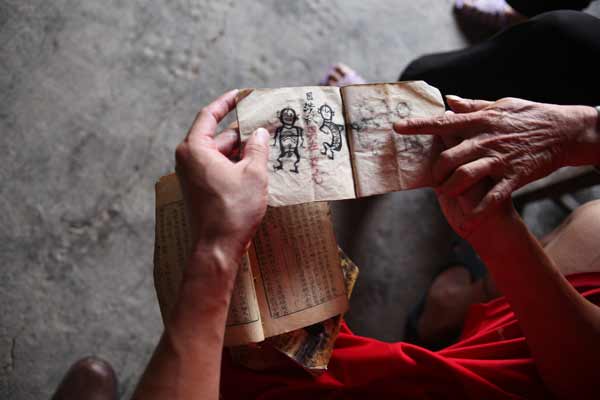

 |
|
A picture book about Yao medicine and medical skills, which has been passed down through generations, is a treasure of Zhao Ruming's family. |
The wet and dim hall of Zhao Ruming's house, surrounded by cob walls, is the guest room as well as a village clinic. An old table in the corner, rumored to have been made in the Qing Dynasty, groans under the weight of dozens of plastic bags and bottles, which were arranged in neat order. Under the table are several large bags of raw materials for herbal medicines.
"I can treat some simple diseases as well," says Li proudly. "The most common medicines used by Yao doctors are for detoxification or to treat inflammation, traumatic injuries, skin diseases, arthropathy, gynopathy and venomous snake bites. In fact, almost all Yao people here know how to deal with the common ailments."
Besides the banners gifted by the patients, a portrait of Chairman Mao and a hierogram of Yao people drawn by Zhao himself are hung on the wall. His wife explains they are there to expel evil.
Countless patients have been treated in this hall, first by Zhao's father Zhao Zhiwen who passed the skills and knowledge on to him.
Yao doctors never ask their patients to pay for treatments. Many of the cases are cured with the help of Zhao and the other Yao doctors for free.
Zhao Demao, the third son of Zhao Ruming, says: "Healing the wounded and rescuing the dying for free is a central part of Yao medicine."
He became a farmer in the village after leaving the army several years ago. He often leafs through the five ancient medicine books left by his great-grandfather.
"I know these books are valuable and I am obliged to inherit the family tradition as the only son working at home. I just need some time," Zhao Demao says. "But who will I treat? The village will become empty in the future."
Zhao's medical skills do not make a big difference to his family's economic condition.
"I don't blame him and I understand it very well," says Li Chenglan. "The happiest thing is to see lives rescued or pain eased, but not the money."
The first time money ruined the peaceful life in the village, according to Li, was in the late 1950s and early 1960s, when local communes purchased bamboo and tung wood in large quantities from the villagers. The bamboo and tung forests were almost destroyed in a few years.
Related:
Members of the Heiyi (black-clothed) Zhuang ethnic group still maintain their traditional lifestyle. But villagers worry it is fast disappearing. More...
For more China Face, here